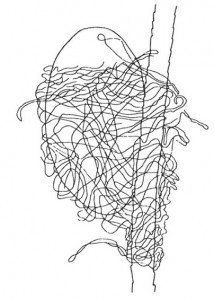
Fur mites lay eggs. Each female lays one or two at a time and they are placed in a distinctive web and secured to a hair close to the skin. This egg hatches into a pre-larva which is similar to a fly larva with finely speckled skin and a few protuberances on the anterior end.
The relevance of this stage is unknown, and the pre-larva does not leave the egg. Inside the pre-larva, a six-legged larva is developed. It is similar in appearance to adult fur mites. When hatching, the empty skin of the pre-larva is left inside the egg while the larva crawls out through the top of the egg. After a while, the larvae attach to a hair, the mouth opening is plugged shot and the larvae remains completely still while the next stage with eight legs develop inside.
When the next stage has developed, the dorsal side of the larval skin splits, and the next stage emerges from the old larval skin. After two more similar molts, the adult females and males are developed. Females are compactly built. Males are slightly smaller and have longer legs. Males and females mate, and the females start to lay eggs. The total development time from egg to egg is not known.




